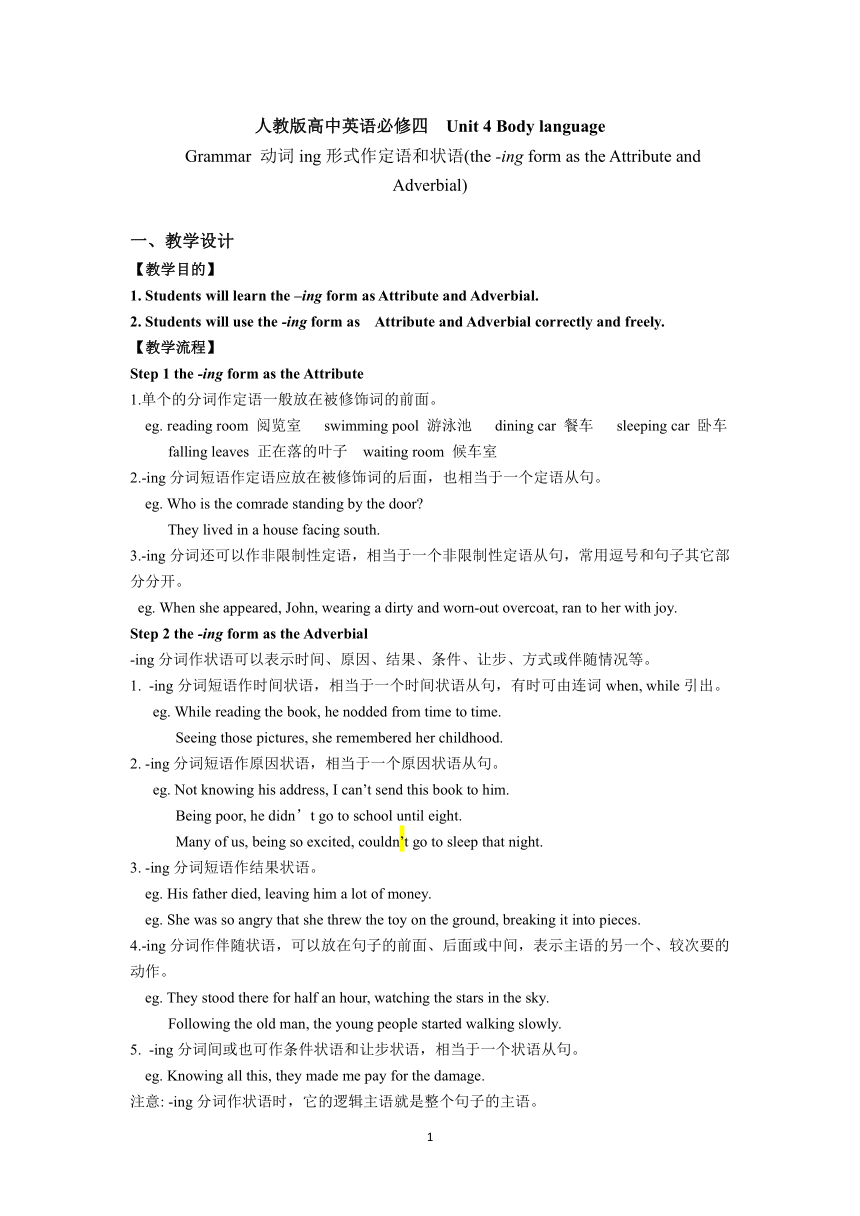人教版(新课程标准)必修四 Unit 4 Body language 动词ing形式作定语和状语教案
文档属性
| 名称 | 人教版(新课程标准)必修四 Unit 4 Body language 动词ing形式作定语和状语教案 |  | |
| 格式 | doc | ||
| 文件大小 | 40.5KB | ||
| 资源类型 | 教案 | ||
| 版本资源 | 人教版(新课程标准) | ||
| 科目 | 英语 | ||
| 更新时间 | 2021-11-14 22:03:15 | ||
图片预览

文档简介
人教版高中英语必修四 Unit 4 Body language
Grammar 动词ing形式作定语和状语(the -ing form as the Attribute and Adverbial)
一、教学设计
【教学目的】
1. Students will learn the –ing form as Attribute and Adverbial.
2. Students will use the -ing form as Attribute and Adverbial correctly and freely.
【教学流程】
Step 1 the -ing form as the Attribute
1.单个的分词作定语一般放在被修饰词的前面。
eg. reading room 阅览室 swimming pool 游泳池 dining car 餐车 sleeping car 卧车
falling leaves 正在落的叶子 waiting room 候车室
2.-ing分词短语作定语应放在被修饰词的后面,也相当于一个定语从句。
eg. Who is the comrade standing by the door
They lived in a house facing south.
-ing分词还可以作非限制性定语,相当于一个非限制性定语从句,常用逗号和句子其它部分分开。
eg. When she appeared, John, wearing a dirty and worn-out overcoat, ran to her with joy.
Step 2 the -ing form as the Adverbial
-ing分词作状语可以表示时间、原因、结果、条件、让步、方式或伴随情况等。
-ing分词短语作时间状语,相当于一个时间状语从句,有时可由连词when, while引出。
eg. While reading the book, he nodded from time to time.
Seeing those pictures, she remembered her childhood.
2. -ing分词短语作原因状语,相当于一个原因状语从句。
eg. Not knowing his address, I can’t send this book to him.
Being poor, he didn’t go to school until eight.
Many of us, being so excited, couldn’t go to sleep that night.
3. -ing分词短语作结果状语。
eg. His father died, leaving him a lot of money.
eg. She was so angry that she threw the toy on the ground, breaking it into pieces.
4.-ing分词作伴随状语,可以放在句子的前面、后面或中间,表示主语的另一个、较次要的动作。
eg. They stood there for half an hour, watching the stars in the sky.
Following the old man, the young people started walking slowly.
-ing分词间或也可作条件状语和让步状语,相当于一个状语从句。
eg. Knowing all this, they made me pay for the damage.
注意: -ing分词作状语时,它的逻辑主语就是整个句子的主语。
6. “with/without+名词普通格或代词宾格+-ing分词”结构在句中作状语,表示伴随情况或时间、原因等。
eg. His hair became grey with the years passing.
Without anyone noticing, he slipped through the window.
注意:
1.-ing形式的完成式作状语时,表明其与句子的主语构成逻辑上的动宾或者主谓关系,且先于谓语动词发生。
eg. Being a student, he was interested in books.
Not having studied his lessons very hard, he failed the examinations.
Having been told many times, he still repeated the same mistakes.
Not having finished the program, they have to stay there for another two weeks.
-ing形式与动词不定式在句中作状语的区别.-ing形式在句中作状语表示时间、原因、方式或伴随情况,而动词不定式一般式在句中作状语时,一般是作目的或结果状语.
即学即练:
指出下列句子中的动名词在句子中所充当的成分,并将句子翻译成中文。
1. The man wearing the sunglasses is a detective.
2. To get there in time, they came running all the way.
3. The student sat there, not knowing what to do.
4. Collecting information is very important for teachers.
5. Being ill, he didn’t take part in the sports meeting.
6. Staying in the seashore for a time, you will feel fresh.
7. Having dressed myself, I went to the office.
8. The old scientist died all of a sudden, leaving the project unfinished.
9. The problem being discussed at the meeting is very important.
10. When Darlene Coulon from France came dashing through the door, she recognized Tony’s smiling face.
Step 3 Summary
The structure of the lesson is as follows:
Step 4 Homework
动词ing形式作定语和状语(the -ing form as the Attribute and Adverbial)
动词ing形式作定语(the -ing form as the Attribute)
动词ing形式作状语(the -ing form as the Adverbial)
Grammar 动词ing形式作定语和状语(the -ing form as the Attribute and Adverbial)
一、教学设计
【教学目的】
1. Students will learn the –ing form as Attribute and Adverbial.
2. Students will use the -ing form as Attribute and Adverbial correctly and freely.
【教学流程】
Step 1 the -ing form as the Attribute
1.单个的分词作定语一般放在被修饰词的前面。
eg. reading room 阅览室 swimming pool 游泳池 dining car 餐车 sleeping car 卧车
falling leaves 正在落的叶子 waiting room 候车室
2.-ing分词短语作定语应放在被修饰词的后面,也相当于一个定语从句。
eg. Who is the comrade standing by the door
They lived in a house facing south.
-ing分词还可以作非限制性定语,相当于一个非限制性定语从句,常用逗号和句子其它部分分开。
eg. When she appeared, John, wearing a dirty and worn-out overcoat, ran to her with joy.
Step 2 the -ing form as the Adverbial
-ing分词作状语可以表示时间、原因、结果、条件、让步、方式或伴随情况等。
-ing分词短语作时间状语,相当于一个时间状语从句,有时可由连词when, while引出。
eg. While reading the book, he nodded from time to time.
Seeing those pictures, she remembered her childhood.
2. -ing分词短语作原因状语,相当于一个原因状语从句。
eg. Not knowing his address, I can’t send this book to him.
Being poor, he didn’t go to school until eight.
Many of us, being so excited, couldn’t go to sleep that night.
3. -ing分词短语作结果状语。
eg. His father died, leaving him a lot of money.
eg. She was so angry that she threw the toy on the ground, breaking it into pieces.
4.-ing分词作伴随状语,可以放在句子的前面、后面或中间,表示主语的另一个、较次要的动作。
eg. They stood there for half an hour, watching the stars in the sky.
Following the old man, the young people started walking slowly.
-ing分词间或也可作条件状语和让步状语,相当于一个状语从句。
eg. Knowing all this, they made me pay for the damage.
注意: -ing分词作状语时,它的逻辑主语就是整个句子的主语。
6. “with/without+名词普通格或代词宾格+-ing分词”结构在句中作状语,表示伴随情况或时间、原因等。
eg. His hair became grey with the years passing.
Without anyone noticing, he slipped through the window.
注意:
1.-ing形式的完成式作状语时,表明其与句子的主语构成逻辑上的动宾或者主谓关系,且先于谓语动词发生。
eg. Being a student, he was interested in books.
Not having studied his lessons very hard, he failed the examinations.
Having been told many times, he still repeated the same mistakes.
Not having finished the program, they have to stay there for another two weeks.
-ing形式与动词不定式在句中作状语的区别.-ing形式在句中作状语表示时间、原因、方式或伴随情况,而动词不定式一般式在句中作状语时,一般是作目的或结果状语.
即学即练:
指出下列句子中的动名词在句子中所充当的成分,并将句子翻译成中文。
1. The man wearing the sunglasses is a detective.
2. To get there in time, they came running all the way.
3. The student sat there, not knowing what to do.
4. Collecting information is very important for teachers.
5. Being ill, he didn’t take part in the sports meeting.
6. Staying in the seashore for a time, you will feel fresh.
7. Having dressed myself, I went to the office.
8. The old scientist died all of a sudden, leaving the project unfinished.
9. The problem being discussed at the meeting is very important.
10. When Darlene Coulon from France came dashing through the door, she recognized Tony’s smiling face.
Step 3 Summary
The structure of the lesson is as follows:
Step 4 Homework
动词ing形式作定语和状语(the -ing form as the Attribute and Adverbial)
动词ing形式作定语(the -ing form as the Attribute)
动词ing形式作状语(the -ing form as the Adverbial)
同课章节目录
